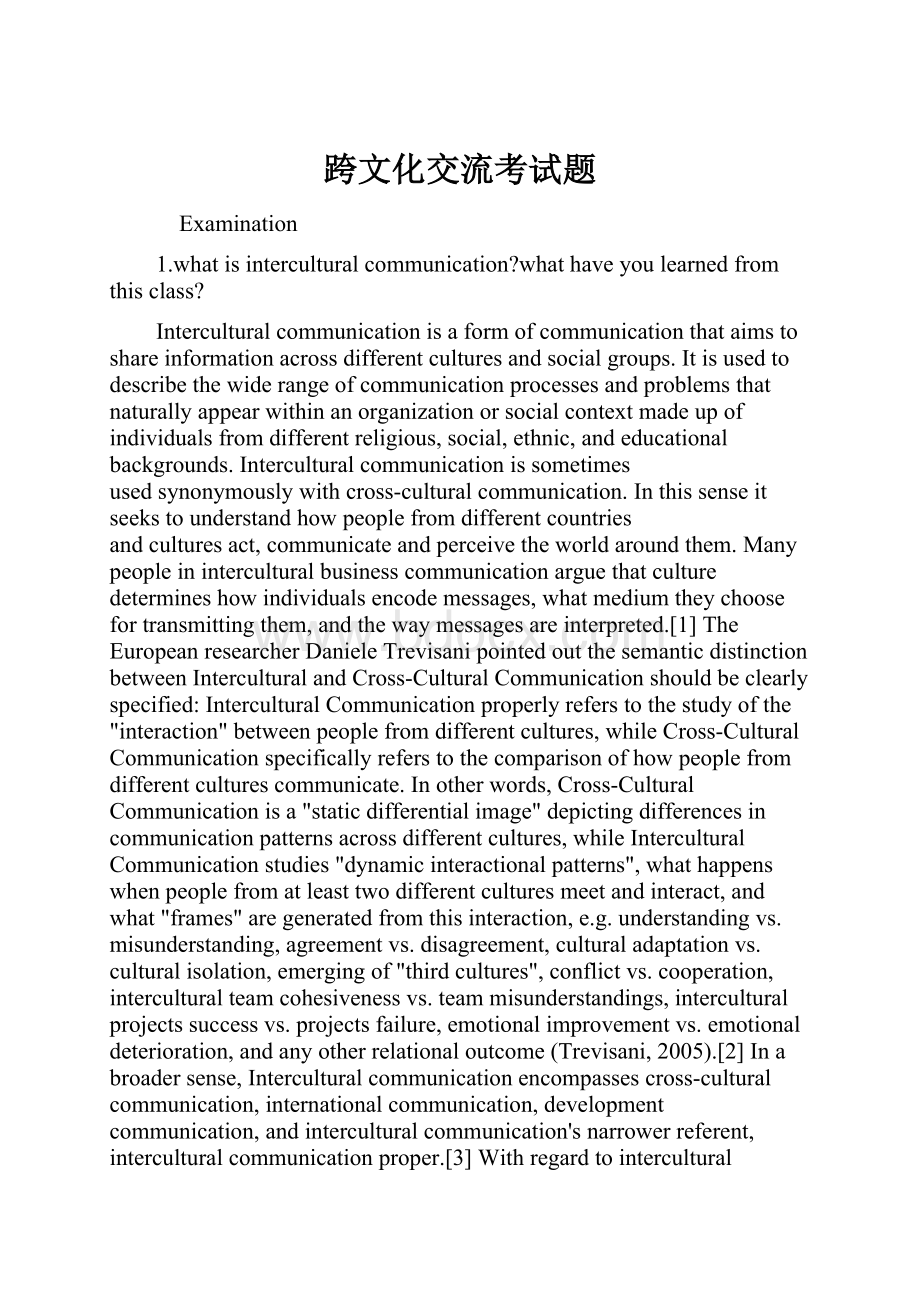跨文化交流考试题.docx
《跨文化交流考试题.docx》由会员分享,可在线阅读,更多相关《跨文化交流考试题.docx(9页珍藏版)》请在冰豆网上搜索。

跨文化交流考试题
Examination
1.whatisinterculturalcommunication?
whathaveyoulearnedfromthisclass?
Interculturalcommunication isaformofcommunicationthataimstoshareinformationacrossdifferentculturesandsocialgroups.Itisusedtodescribethewiderangeofcommunicationprocessesandproblemsthatnaturallyappearwithinanorganizationorsocialcontextmadeupofindividualsfromdifferentreligious,social,ethnic,andeducationalbackgrounds.Interculturalcommunicationissometimesused synonymously with cross-culturalcommunication.Inthissenseitseekstounderstandhowpeoplefromdifferentcountriesand cultures act, communicate and perceive theworldaroundthem.Manypeopleininterculturalbusinesscommunicationarguethatculturedetermineshowindividualsencodemessages,whatmediumtheychoosefortransmittingthem,andthewaymessagesareinterpreted.[1] TheEuropeanresearcherDanieleTrevisanipointedoutthesemanticdistinctionbetweenInterculturalandCross-CulturalCommunicationshouldbeclearlyspecified:
InterculturalCommunicationproperlyreferstothestudyofthe"interaction"betweenpeoplefromdifferentcultures,whileCross-CulturalCommunicationspecificallyreferstothecomparisonofhowpeoplefromdifferentculturescommunicate.Inotherwords,Cross-CulturalCommunicationisa"staticdifferentialimage"depictingdifferencesincommunicationpatternsacrossdifferentcultures,whileInterculturalCommunicationstudies"dynamicinteractionalpatterns",whathappenswhenpeoplefromatleasttwodifferentculturesmeetandinteract,andwhat"frames"aregeneratedfromthisinteraction,e.g.understandingvs.misunderstanding,agreementvs.disagreement,culturaladaptationvs.culturalisolation,emergingof"thirdcultures",conflictvs.cooperation,interculturalteamcohesivenessvs.teammisunderstandings,interculturalprojectssuccessvs.projectsfailure,emotionalimprovementvs.emotionaldeterioration,andanyotherrelationaloutcome(Trevisani,2005).[2] Inabroadersense,Interculturalcommunicationencompasses cross-culturalcommunication, internationalcommunication, developmentcommunication,andinterculturalcommunication'snarrowerreferent,interculturalcommunicationproper.[3] Withregardtointerculturalcommunicationproper,itstudiessituationswherepeoplefromdifferentculturalbackgrounds interact.Asidefromlanguage,interculturalcommunicationfocusesonsocialattributes,thoughtpatterns,andtheculturesofdifferentgroupsofpeople.Italsoinvolvesunderstandingthedifferentcultures,languagesandcustomsofpeoplefromothercountries.Interculturalcommunicationplaysarolein socialsciences suchasanthropology, culturalstudies, linguistics, psychology and communicationstudies.Interculturalcommunicationisalsoreferredtoasthebaseforinternationalbusinesses.Thereareseveralcross-culturalserviceprovidersaroundwhocanassistwiththedevelopmentofinterculturalcommunicationskills.Researchisamajorpartofthedevelopmentofinterculturalcommunicationskills.[4][5]
2.Explainthedifferencebetweenverbalcommunicationandnon-verbalcommunicationindetails.
--Verbalcommunication
consistofmessagesbeingsentandreceivedcontinuously withthespeakerandthelistener,itisfocusedonthewaymessagesareportrayed.Verbalcommunicationisbasedonlanguageanduseofexpression,thetoneinwhichthesenderofthemessagerelaysthecommunicationcandeterminehowthemessageisreceivedandinwhatcontext.
Factorsthateffectverbalcommunication:
∙Toneofvoice
∙Useofdescriptivewords
∙Emphasisoncertainphrases
∙Volumeofvoice
Thewayamessageisreceivedisdependentonthesefactorsastheygiveagreaterinterpretationforthereceiverastowhatismeantbythemessageis.Byemphasizingacertainphrasewiththetoneofvoice,thisindicatesthatitisimportantandshebefocusedmoreon.
Alongwiththeseattributes verbalcommunicationisalsoaccompaniedwithnon-verbalcues.Thesecuesmakethemessageclearerandgivethelisteneranindicationofwhatwaytheinformationshouldbereceived.[23]
Exampleofnon-verbalcues
∙Facialexpressions
∙Handgestures
∙Useofobjects
∙Bodymovement
Intermsofinterculturalcommunicationtherearelanguagebarrierswhichareeffectedbyverbalformsofcommunication.Inthisinstancethereisopportunityformiscommunicationbetweentwoormoreparties.[24] Otherbarriersthatcontributetomiscommunicationwouldbethetypeofwordschoseninconversation.dotodifferentculturestherearedifferentmeaninginvocabularychosen,thisallowsforamessagebetweenthesenderandreceivertobemisconstrued.[25]
6.Explaintheprosandconsofnonverbalcommunication.
NonverbalCommunication[edit]
Nonverbalcommunication isbehaviorthatcommunicateswithoutwords—thoughitoftenmayaccompaniedbywords.Nonverbalbehaviorcanincludethingssuchas
∙facialexpressionsandgestures
∙clothing
∙movement
∙posture
∙eyecontact.[26]
Whentheseactionsarepairedwithverbalcommunicationamessageiscreatedandsentout.Aformofnonverbalcommunicationiskinesicbehaviour.Kinesicbehaviouriscommunicationthroughbodymovement—e.g.,posture,gestures,facialexpressionsandeyecontact.Themeaningofsuchbehaviourvariesacrosscountriesandaffectsinterculturalcommunication.Aformofkinesicnonverbalcommunicationiseyecontactandtheuseoftheeyestoconveymessages.Overall,nonverbalcommunicationgivescluestowhatisbeingsaidverballybyphysicalportrayals.
Nonverbalcommunicationtechniquesusedaroundtheworldandinmultiplecultures.
Nonverbalcommunicationandkinesicisnottheonlywaytocommunicatewithoutwords. Proxemics,aformofnonverbalcommunication,dealswiththeinfluenceofproximityandspaceoncommunication.Anotherformofnonverbalbehaviourandcommunicationdealingwithinterculturalcommunicationisparalanguage. Paralanguage referstohowsomethingissaid,ratherthanthecontentofwhatissaid—e.g.,rateofspeech,toneandinflectionofvoice,othernoises,laughing,yawning,andsilence.Paralanguagewillbelatertouchedonintheverbalsectionofinterculturalcommunication.
Nonverbalcommunicationhasbeenshowntoaccountforbetween65%and93%ofinterpretedcommunication.[27] Minorvariationsinbodylanguage,speechrhythms,andpunctualityoftencausemistrustandmisperceptionofthesituationamongcross-culturalparties.Thisiswherenonverbalcommunicationcancauseproblemswithinterculturalcommunication.Misunderstandingswithnonverbalcommunicationcanleadtomiscommunicationandinsultswithculturaldifferences.Forexample,ahandshakeinoneculturemayberecognizedasappropriate,whereasanotherculturemayrecognizeitasrudeorinappropriate.[27]
Nonverbalcommunicationcanbeusedwithouttheuseofverbalcommunication.Thiscanbeusedasacodingsystemforpeoplewhodonotuseverbalbehaviourtocommunicateindifferentcultures,wherespeakingisnotallowed.[28] Anfacialexpressioncangivecuestoanotherpersonandsendamessage,withoutusingverbalcommunication.
Somethingthatusuallygoesunnoticedinculturesandcommunicationisthatclothingandthewaypeopledressisusedasaformofnonverbalcommunication.Whatapersonwearscantellalotaboutthem.Forexample,whethersomeoneispoororrich,youngoroldoriftheyhavespecificculturesandbeliefscanallbesaidthroughclothingandstyle.Thisisaformofnonverbalcommunication.
Overall,nonverbalcommunicationisaveryimportantconceptininterculturalcommunication.
3.BasedontheKluekhohn’smodel,explainAmericanCultureValueindetail.
1)=Humannatureorientation人性取向
Westernersbelievethathumannatureisbasicallyevilduetotheiroriginalsin.However,theevilnaturecanbesavedthroughsalvation,ifonebelievesinJesusandcontinuesdoinggoodthings.
2)=Man-natureorientation人天取向
Americanshavehistoricallybelievedthatnaturewassomethingthatcouldandhadtobemastered.EarlyWestEuropeanimmigrantstoNorthAmericaencounteredavast,unforgivingwildernessthattheysetaboutto“tame”,andmodernastronautareworkingto“conquer”thespace.
3)=Timeorientation时间取向
Future-orientatedculturesemphasizewhatistocomeandexpectthefuturetobegranderandnicerthanthepresent.Theword“old”isassociatedwith“fallingbehind”and“uselessness”,whiletheword“new”isrelatedtoprogress,changeandchallenge.
futureorientationprevailsinthewesternculture.Westernpeopletendtobelievethatfutureshouldbegranderandnicerthanthepresent.Inthefuture-orientedculturalcontext,itiseasyfornewproductsornewservicestotriggerconsumersdesiretobuy.ThatiswhytheEnglishadvertisementstendtostressrepeatedlythattheadvertisedproductsarenew。
4)=Activityorientation行为取向
Thekeytodoingorientationisavaluesystemthatstressactivityandaction.
ThedominantAmericanculture:
Americansareactionorientated,theyarego-getters.Theygetgoing,getthingsdone,andgetahead.InAmerica,peoplegatherforaction-toplaybasketball,todance,togototheconcert,andtotakerisks.Whengroupsgathertheyplaygamesorwatchvideos.ManyAmericansdonothavepatiencetositdownandtalk.Lifeisinconstantmotion.
5)=Socialorientation人际取向
Americanhastheindividualisticvalues,eachpersonisseenasautonomousandseparate.Everyoneisequal.Selfismoreimportantthangroup.Theself-reliance,individualfreedom,equalcompetitionwhichareemphasizedisdifferentfromtheconceptofindividualisminChina.InAmerican’ssocialvalues,Equalopportunityandpersonalfreedomarethebasicfoundationforeverymemberof